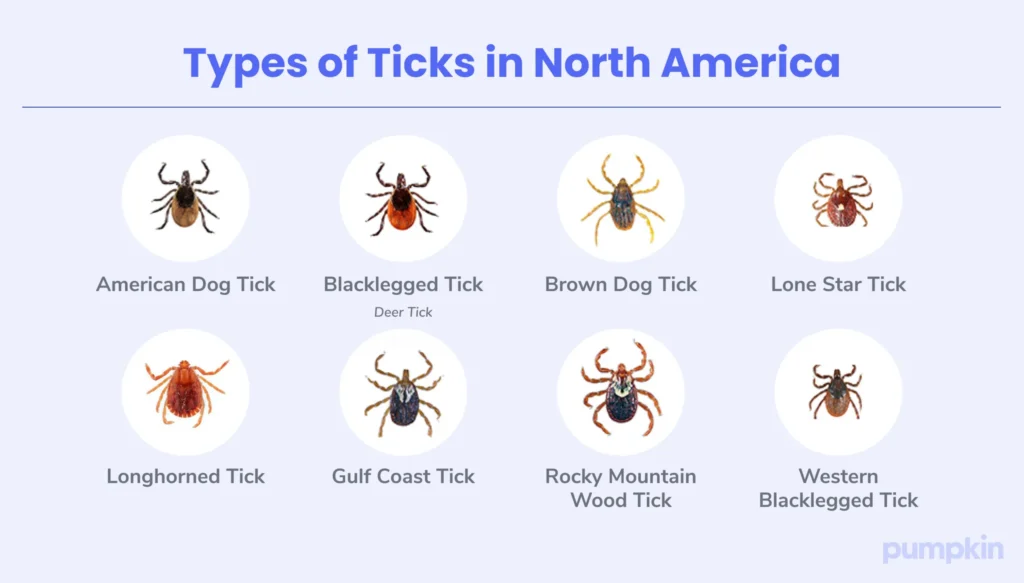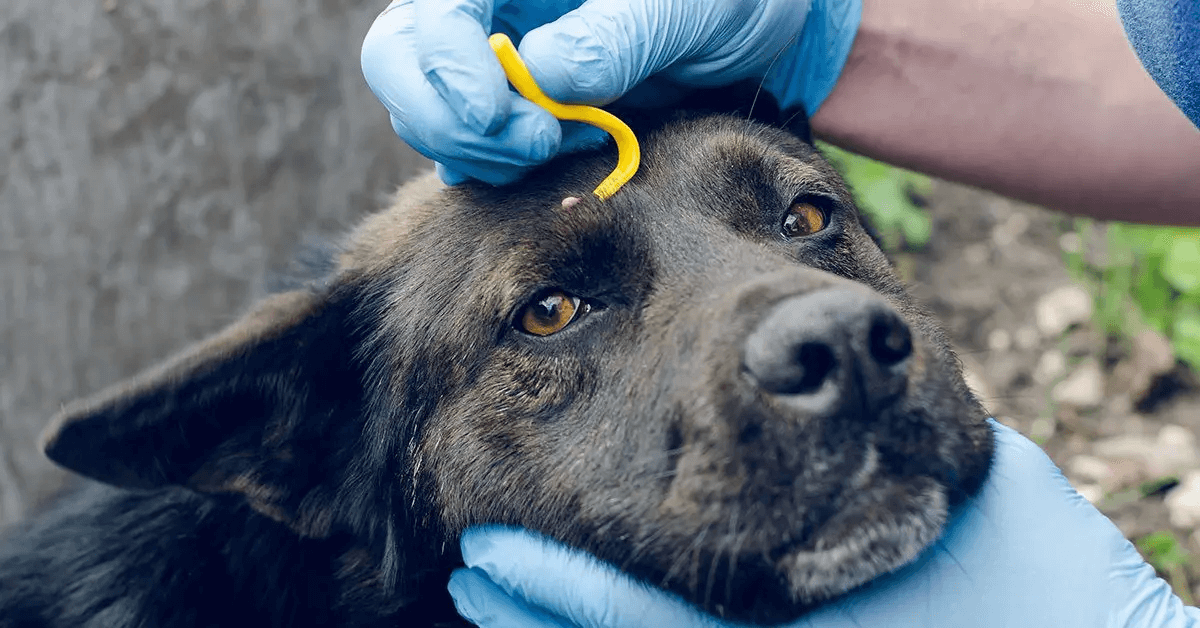Key Points
- Not all ticks pose the same risks to your dog, there are five species that all have different habitats and varying threats to your pets.
- Identifying common tick species and taking preventive measures can help avoid tick-related illnesses.
- There are many ways to protect and prevent tick-borne diseases, including using flea and tick prevention medications. You can significantly reduce the risk of tick-related illnesses for your dog.
Ticks are more than just a nuisance for dogs – they can pose a health risk with some of the tick-borne diseases they carry, like tick paralysis. The damage they leave behind from their bites is usually relatively minimal, but it’s what’s transferred in that bite that is more a cause for concern.
With several species of ticks spread across regions, dog owners need to be aware of the different types of ticks that could pose a threat, especially since each type may carry its own risks. Whether you’re hiking through wooded areas, enjoying a stroll in the park, or even letting your pup roam in your backyard, these pests can be lurking and waiting for their next host.
Knowing how to recognize ticks and understanding their habits is the first step in protecting your dog. Armed with the right knowledge and tools, you can keep your dog safe from these potentially harmful hitchhikers. Plus, did you know the Pumpkin Wellness Club can help you save up to $460 per year on routine care and more – including $150 for tick prevention?* Just something to consider while you learn more about these troublesome arachnids.
Read on to discover the eight types of ticks every dog owner should be familiar with, and learn how to safeguard your canine companion.
Types of ticks in North America

There are several types of ticks that pose risks to dogs across North America, but their prevalence and threat levels vary by region. In the United States, ticks are most active from spring through fall, coinciding with the time when many people are outdoors with their dogs, whether hiking, hunting, or working on farms. During these warmer months, ticks are more likely to latch onto your dog, increasing the risk of transmitting diseases.
As the weather cools, ticks typically go dormant during the winter. This seasonal activity pattern emphasizes the importance of heightened precaution during peak seasons.
American dog tick (Dermacentor variabilis, D. similis)
The American dog tick is commonly found in grassy fields, walkways, and shrubs, particularly in the eastern United States and along the Pacific Coast. They are larger than some other ticks, with brown bodies and white or grayish markings on their backs.
These ticks can transmit Rocky Mountain spotted fever and tularemia. Like most tick species that dogs are at risk of being bitten by, they aren’t too fussy about where they feed and can also bite humans when the chance arises.
Blacklegged tick (Ixodes scapularis)
The blacklegged tick, also known as the deer tick, is commonly found in wooded areas and grassy regions, especially in the northeastern, mid-Atlantic, and upper midwest United States.
They are identifiable by their small size, reddish-orange bodies, and dark black legs. These ticks are notorious for transmitting Lyme disease, among other illnesses, posing significant health risks to both you and your dogs. In addition to Lyme disease, these ticks are known to transmit babesiosis as well, a disease caused by Babesia organisms, that attacks red blood cells.
Brown dog tick (Rhipicephalus sanguineus)
The brown dog tick is often found in kennels, homes, and other indoor environments, favoring warm and dry conditions. They are reddish-brown and smaller than many other tick species, with an elongated body shape.
Unlike many ticks, they can survive and reproduce indoors. These ticks are known to transmit diseases like ehrlichiosis and can cause tick infestations in homes which can put both your two and four-legged family members at risk.
Lone star tick (Amblyomma americanum)
The lone star tick is commonly found in wooded areas, grassy meadows, and along trails, predominantly in the southeastern and eastern United States. They are identifiable by a distinctive white or silver spot on the back of adult females.
Lone star ticks can transmit diseases such as ehrlichiosis, tularemia, and Southern tick-associated rash illness (STARI). Additionally, their bites have been linked to alpha-gal syndrome, causing a red meat allergy.
Longhorned tick (Haemaphysalis longicornis)
The longhorned tick, originally native to East Asia, has been found in various parts of the United States. These ticks are small and reddish-brown, often difficult to detect due to their size. They can reproduce rapidly without a mate, leading to infestations.
Longhorned ticks are known to transmit diseases such as anaplasmosis and theileriosis, and they pose risks to dogs, cats, livestock and humans through blood loss and potential pathogen transmission.
Gulf Coast Tick (Amblyomma maculatum)
The Gulf Coast tick is commonly found in coastal regions of the United States. Known for its ornate appearance, this tick can transmit diseases such as Rickettsia parkeri rickettsiosis, a form of spotted fever.
It poses a risk to both humans and animals, especially through bites that may lead to infections or severe reactions. These ticks are often found in grassy or brush-filled areas, making preventive measures critical for minimizing exposure and protecting pets and livestock.
The Rocky Mountain wood tick (Dermacentor andersoni)
The Rocky Mountain wood tick is largely found in the western United States and southwestern Canada, typically inhabiting grassy and shrubby areas. This tick is a known vector of diseases such as Colorado tick fever, tularemia, and Rocky Mountain spotted fever.
It mainly feeds on mammals, including dogs, and poses the greatest risk during spring and early summer. Preventive measures like using tick treatments are important to reduce exposure and risk of tick-borne illnesses.
The Western blacklegged tick (Ixodes pacificus)
The western blacklegged tick is primarily found along the Pacific Coast of the United States, thriving in forested and brushy areas. This tick is a key vector of Lyme disease and anaplasmosis in the region.
The western blacklegged tick can be identified by its small, flat body and contrasting coloration. Adult females have a reddish-orange body with a distinctive black shield-like area, called the scutum, just behind the head. Males are smaller than females and are uniformly dark brown or black. Nymphs and adult females typically pose the highest risk to pets and humans, with peak activity in spring and early summer.
What type of tick carries Lyme disease?
The primary tick responsible for carrying Lyme disease in the U.S. is the blacklegged tick, also known as the deer tick. The types of ticks that carry Lyme disease are commonly found in wooded or grassy areas, particularly in northeastern, midwestern, and mid-Atlantic states.
The disease is transmitted through the bite of an infected tick, often requiring it to stay attached for 36-48 hours.
Symptoms of Lyme disease include fever, fatigue, headache, and a distinctive bull’s-eye rash around the bite area (though not always present). If untreated, it can lead to joint pain, neurological issues, and heart complications.
Ticks come in different shapes and sizes

Ticks vary significantly in size depending on the stage of their life cycle and whether they have recently fed. At the larva stage, ticks are extremely small, often no bigger than a pinhead. Nymphs are slightly larger but still tiny, about the size of a poppy seed.
Adult ticks are more visible, roughly the size of an apple seed. Their size also increases dramatically after feeding, as their bodies expand to accommodate the blood they’ve consumed, making them easier to spot.
You’ve identified a tick, now what?
Tick bites can be scary but removal is pretty straightforward. Using tweezers or a tick removal tool is an effective way to remove ticks from your pet. Grip the tick as close to the skin as possible and pull upward with steady, even pressure, avoiding twisting or jerking. Ensure the entire tick is removed, including the head.
After removal, clean the area with antiseptic cream or spray, helping to prevent infection. Monitor your dog for unusual symptoms, such as swelling, lethargy, or loss of appetite. If you notice any signs of infection or unusual behavior, consult your vet promptly.
Tick prevention is crucial
Prevention is always better than treatment when it comes to protecting your dog from ticks and the illnesses they can transmit. Using monthly flea and tick prevention products is an essential step in safeguarding your pet from these harmful parasites.
Performing regular inspections on your dog, especially after walks or outdoor play, helps identify and remove ticks before they can cause harm. This is particularly important as some ticks can cause more severe conditions, like tick paralysis, which can lead to weakness, difficulty walking, and even respiratory issues if left untreated.
For dogs in areas where Lyme disease is prevalent, a Lyme disease vaccine is also available and highly recommended. Taking these proactive measures reduces the risk of tick-borne illnesses and ensures your dog remains happy, healthy, and protected all year round.
An extra layer of protection
Ticks are more than just a nuisance. They’re a real health threat to dogs. Learning to identify the common types of ticks in North America and taking proactive steps to protect your pup will prevent tick-related illnesses, giving you peace of mind. If your dog or cat does end up with one, its important to know how to remove ticks safely. To prevent ticks, ensure your pet is covered year-round by talking to your vet about flea and tick prevention medications, collars, and topical options.
FAQs
*Pumpkin Wellness Club is marketed and administered by Sprout Wellness Services LLC (d/b/a “Pumpkin Wellness Club”). Pumpkin Wellness Club is not an insurance policy. It is offered as a standalone pet wellness membership program. For full terms, visit wellness.pumpkin.care/membership-agreement.
- https://projectlyme.org/resource/types-of-ticks/
- https://www.westportveterinary.com/site/blog-westport-vet/2021/01/11/tick-borne-diseases-dogs
- https://www.ticklab.org/deer-tick
- https://vcahospitals.com/know-your-pet/ehrlichiosis-in-dogs
- https://pmc.ncbi.nlm.nih.gov/articles/PMC6789585/
- https://www.zoetispetcare.com/blog/article/gulf-coast-tick
- https://wwwnc.cdc.gov/eid/article/16/5/09-1314_article
- https://web.uri.edu/tickencounter/species/rocky-mountain-wood-tick/
- https://www.cdc.gov/ticks/data-research/facts-stats/western-blacklegged-tick-surveillance.html
- https://www.aaha.org/resources/2022-aaha-canine-vaccination-guidelines/borrelia-lyme-disease/
- https://www.healthline.com/health/dog-tick-vs-deer-tick#comparison-chart




